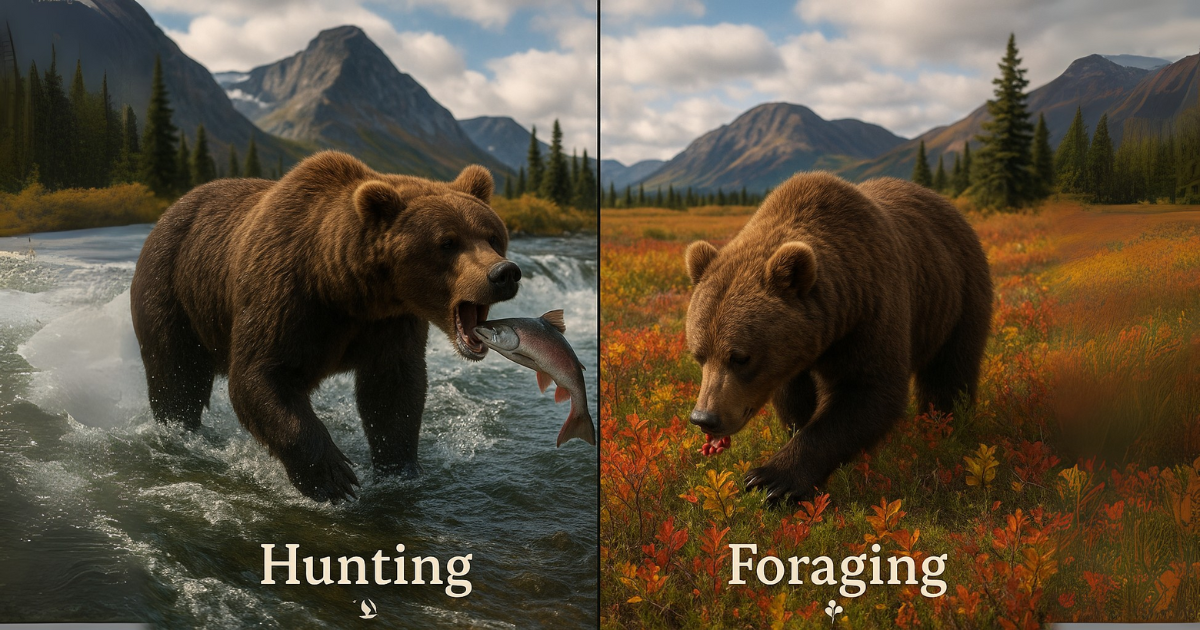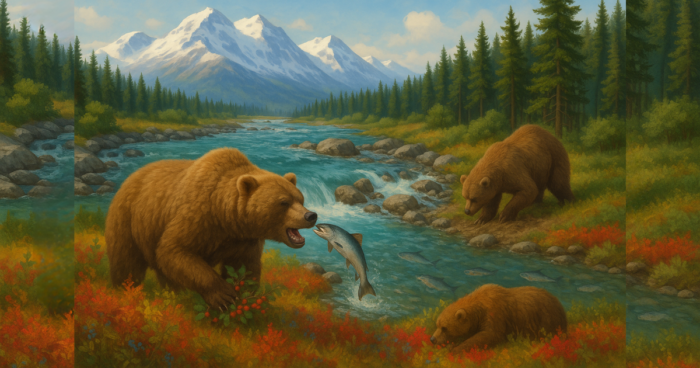Wondering what grizzly bears eat in Alaska? These powerful omnivores thrive on a rich variety of seasonal foods, from salmon to berries, to prepare for the state’s long and harsh winters. Alaska’s diverse landscapes, coastal rivers, tundra, and forests provide abundant resources that influence grizzly feeding habits. Their flexible diet enables them to survive in diverse regions, ranging from salmon-rich coastal areas to inland tundras where plant matter and carrion are more abundant. Understanding what grizzly bears eat in Alaska helps reveal how these iconic animals play a vital role in maintaining healthy ecosystems and sustaining the balance of predator and prey.
Grizzly Bear Diet in the Wild
Grizzly bears are classified as omnivores, meaning they consume both plants and animals. Despite their fearsome reputation, most of their calories come from vegetation. However, they require a high caloric intake, up to 20,000 calories a day in peak feeding seasons, to build fat reserves for winter hibernation.
The diet of grizzly bears in the wild varies depending on their habitat and the season. Coastal bears benefit from nutrient-rich salmon runs, while inland bears rely more on roots, berries, and scavenged animal carcasses. Their ability to adapt their diet to local food availability ensures their survival across Alaska’s varied ecosystems.
A Seasonal Breakdown of Grizzly Bear Foods
To fully understand what grizzly bears eat in Alaska, we need to examine their changing diet throughout the year. Food availability varies greatly with the seasons, influencing their feeding behaviors and nutritional strategies.
Spring – Waking Up and Seeking Protein
In early spring, food is scarce, and bears emerging from hibernation seek high-protein sources. Carrion and animal prey for bears become vital, as they scavenge winter-killed moose, caribou, or fish remains. They may also hunt vulnerable newborn moose or caribou calves. This protein intake helps rebuild muscle lost during hibernation and replenishes energy reserves for the coming months.
Summer – Feeding on Abundant Plant Life
Summer brings an abundance of vegetation, and grizzly bears and berry consumption become central to their diet. They eat grasses, sedges, roots, and a wide variety of berries, including blueberries, crowberries, and salmonberries. These carbohydrate-rich foods are crucial for gradual fat accumulation. Summer is also when bears roam extensively, expanding their range to take advantage of ripening berry patches across the landscape.
Late Summer – Salmon Season Begins
As salmon runs begin, Alaskan salmon feeding habits dominate coastal grizzly diets. Bears congregate at rivers like Brooks River in Katmai National Park, catching salmon in shallow waters or at falls. The high-fat content of salmon accelerates weight gain, allowing bears to store significant fat before winter. Salmon runs are so critical that coastal grizzlies can double their weight in just a few months.
Fall – Calorie Loading Before Hibernation
In fall, the seasonal diet of grizzly bears shifts to hyperphagia, a feeding frenzy where they consume as many calories as possible. They continue to eat salmon where available, as well as late-season berries and roots. Bears spend most of their day foraging, sometimes eating nonstop for up to 20 hours. This intense feeding ensures they have enough fat to survive hibernation without eating or drinking for months.
Hunting vs. Foraging: How Grizzlies Source Their Food

Grizzlies are opportunistic hunters, taking advantage of moose calves, ground squirrels, and even fish when conditions allow. However, they are not specialized predators and rarely rely solely on hunting.
How grizzlies hunt in Alaska depends on regional resources. Coastal bears often fish for salmon, while inland bears rely on scavenging or digging for rodents. Their adaptability ensures survival in ecosystems ranging from forests to tundra.
Grizzlies, Brown Bears, and Diet Differences
Alaskan grizzlies are technically a type of brown bear, but their diets vary based on location. Coastal brown bears have access to salmon and rich marine resources, while inland grizzlies consume more plant matter and carrion.
This distinction explains the brown bears vs grizzly bears diet differences. Coastal bears grow larger thanks to high-fat salmon diets, while inland grizzlies remain smaller due to less protein-rich food sources.
Food Sources in Alaska’s National Parks
The food sources in Alaska’s national parks are diverse, supporting healthy bear populations. Katmai and Lake Clark provide salmon-rich rivers, while Denali offers vast berry patches and open tundra for scavenging.
These protected ecosystems limit human interference and ensure bears have access to natural food sources essential for survival.
Hibernation and Fat Storage in Bears
Hibernation and fat storage in bears are closely linked to their seasonal diet. By late fall, grizzlies rely on accumulated fat to survive months of inactivity during winter. Their fat reserves provide both energy and water, as they do not eat, drink, or excrete while hibernating.
Human-Bear Food Conflicts in Alaska
Human-bear food conflicts in Alaska occur when bears gain access to unsecured food or garbage. This can lead to dangerous habituation and aggressive behavior.
To reduce risks, state parks encourage the use of bear-proof containers and strict campsite food storage rules, keeping both humans and bears safe.
Conclusion
Grizzly bears are remarkably adaptable omnivores whose diet changes dramatically with the seasons. From salmon-rich rivers to inland berry fields, Alaska provides the resources they need to thrive. Now that you know what grizzly bears eat in Alaska, you can better appreciate their ecological importance and the need to protect their natural food sources.


